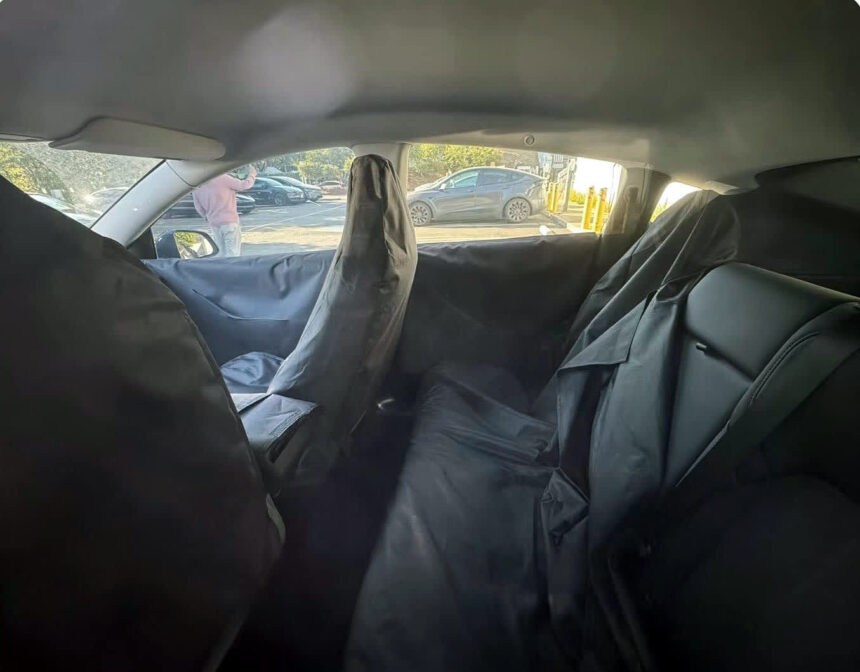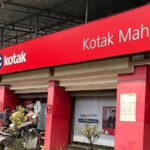Tesla’s upcoming budget Model Y variant represents a paradigm shift in affordable electric vehicle design, eliminating the problematic panoramic glass roof while offering a stripped-down yet functional interior at Rs 59.89 lakh. This budget-oriented approach addresses chronic glass roof leak issues that have plagued Tesla owners worldwide while delivering the core Tesla experience through strategic feature reduction. The barebones interior design philosophy prioritizes essential functionality over luxury amenities, creating India’s most accessible Tesla ownership experience without compromising on safety or basic performance capabilities.
Recent leaked footage from Tesla’s Shanghai Gigafactory reveals the Project E41 budget Model Y featuring significant cost-reduction measures including the elimination of ventilated seats, rear display screen, cupholder storage, and most notably, the complete removal of the panoramic glass roof structure that has been a source of expensive repair bills and water damage complaints. This strategic decontenting allows Tesla to offer genuine electric mobility at a more quality issues in their product lineup.
Read More : MG Cyberster Launches at ₹72.49L – India’s First Electric Roadster
Revolutionary Design Philosophy: Function Over Luxury
Exterior Modifications for Cost Optimization
The budget Model Y features substantial exterior modifications that distinguish it from the premium Juniper refresh variants. The headlights have been repositioned upward, indicating the removal of the signature LED light bar that defines the premium Model Y aesthetic. The rear design eliminates the indirect light reflector that creates the distinctive red light splash pattern on the asphalt, replacing it with conventional taillights for cost savings.
The elimination of the panoramic glass roof represents the most significant visual change, replacing the expansive glass surface with a conventional metal roof structure. This modification addresses the $1,700 replacement cost associated with glass roof damage while eliminating the structural vulnerability that has led to catastrophic failures during extreme weather conditions. The gray insert at the rear has been replaced with painted body panels, creating a more uniform appearance while reducing manufacturing complexity.
Front bumper modifications include the addition of a front-facing camera while maintaining the essential sensor array for Tesla’s Autopilot functionality. The overall dimensions remain consistent with the standard Model Y, suggesting Tesla has maintained the same platform architecture while reducing complexity through component elimination rather than fundamental redesign.
Read More : iQOO Z10R 5G Launched in India: Complete Price, Specifications & Features Guide 2025
Interior Simplification Strategy
The barebones interior represents a calculated reduction of non-essential features while maintaining core Tesla functionality. The ventilated front seats have been eliminated, replaced with standard heating-only functionality using basic vegan leather with cloth elements. This modification reduces both initial cost and potential maintenance requirements associated with complex ventilation systems.

The central console redesign removes the cupholder storage compartment, simplifying the interior architecture similar to Tesla’s approach with the base Cybertruck variant. The rear display screen has been completely eliminated, reducing both cost and potential points of failure while simplifying the electrical architecture. Audio system modifications include the removal of A-pillar speakers, though the primary sound system remains functional through the central speaker array.
Read More : SBI PO Prelims 2025: August Exam Dates & Preparation Guide
Convenience features have been systematically removed, including clothing hooks above the window rim and various storage compartments that add manufacturing complexity. However, the essential 15.4-inch central touchscreen remains unchanged, ensuring that core Tesla functionality including navigation, entertainment, and vehicle controls remain fully accessible to budget-conscious buyers.
Glass Roof Elimination: Solving Tesla’s Persistent Problem
Historical Context of Glass Roof Issues
Tesla’s panoramic glass roof, while aesthetically striking, has generated consistent complaints regarding water leaks, structural failures, and expensive replacement costs. Multiple documented cases show catastrophic roof failures, including instances where the entire glass panel separated from vehicles traveling at highway speeds, creating dangerous situations for occupants and other drivers.
Water infiltration problems have been particularly problematic, with owners reporting water damage to interior electronics, headliner staining, and mold growth in affected vehicles. The complex sealing requirements for the large glass panel create multiple potential failure points, particularly around mounting brackets and edge seals where structural stress concentrates.
Read More : Google AI Overviews: A 2025 SEO Survival Playbook
Repair costs have proven prohibitive for many owners, with Tesla service centers quoting $1,700 for glass roof replacement. Third-party repair options remain limited due to the specialized nature of the glass panel and the precision required for proper installation. This has created a significant ownership burden for affected customers, particularly those outside warranty coverage.
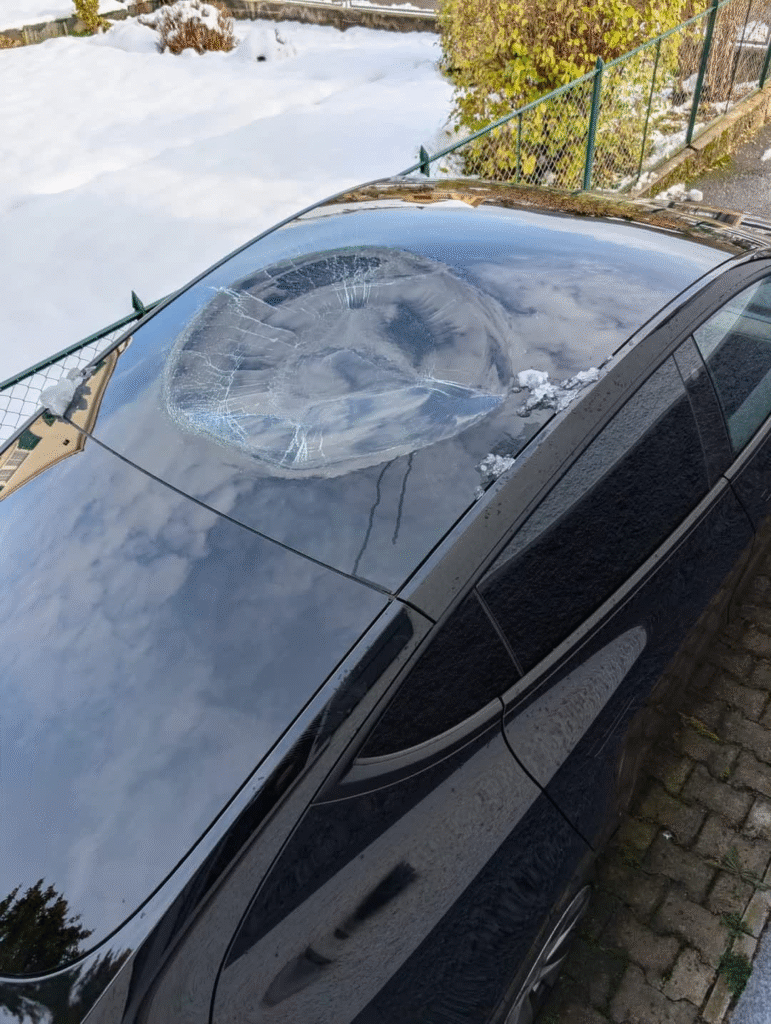
Engineering Benefits of Conventional Roof Design
The elimination of the glass roof provides multiple engineering advantages beyond cost reduction. Structural rigidity increases substantially with a conventional metal roof, improving crash safety ratings and reducing body flex during dynamic driving situations. The lower center of gravity achieved through metal roof construction enhances handling characteristics and stability.
Thermal management improves significantly without the greenhouse effect created by extensive glass surfaces. The conventional roof eliminates heat buildup issues that require additional air conditioning capacity, improving both comfort and energy efficiency. UV protection becomes complete rather than dependent on glass coatings that may degrade over time.
Manufacturing simplification reduces assembly complexity and potential quality control issues. The conventional roof structure integrates more readily with standard automotive manufacturing processes, reducing the specialized handling and precision assembly required for glass installation. This translates to improved production efficiency and reduced warranty claims related to roof assembly defects.
Long-term Reliability Improvements
Budget Model Y owners will benefit from elimination of glass-related maintenance issues that have plagued premium variant owners. Seal degradation, mounting bracket corrosion, and glass stress cracking become non-issues with conventional roof construction. The simplified design reduces potential failure points and associated repair costs throughout the vehicle’s lifecycle.
Read More : War 2 Movie: Hrithik & Jr NTR’s Epic Battle Awaits
Weather resistance improves dramatically without large glass surfaces that can develop micro-cracks or seal failures over time. Extreme temperature cycling has less impact on metal roof structures compared to glass panels that expand and contract significantly with temperature changes. This is particularly relevant for Indian climate conditions with extreme seasonal temperature variations.
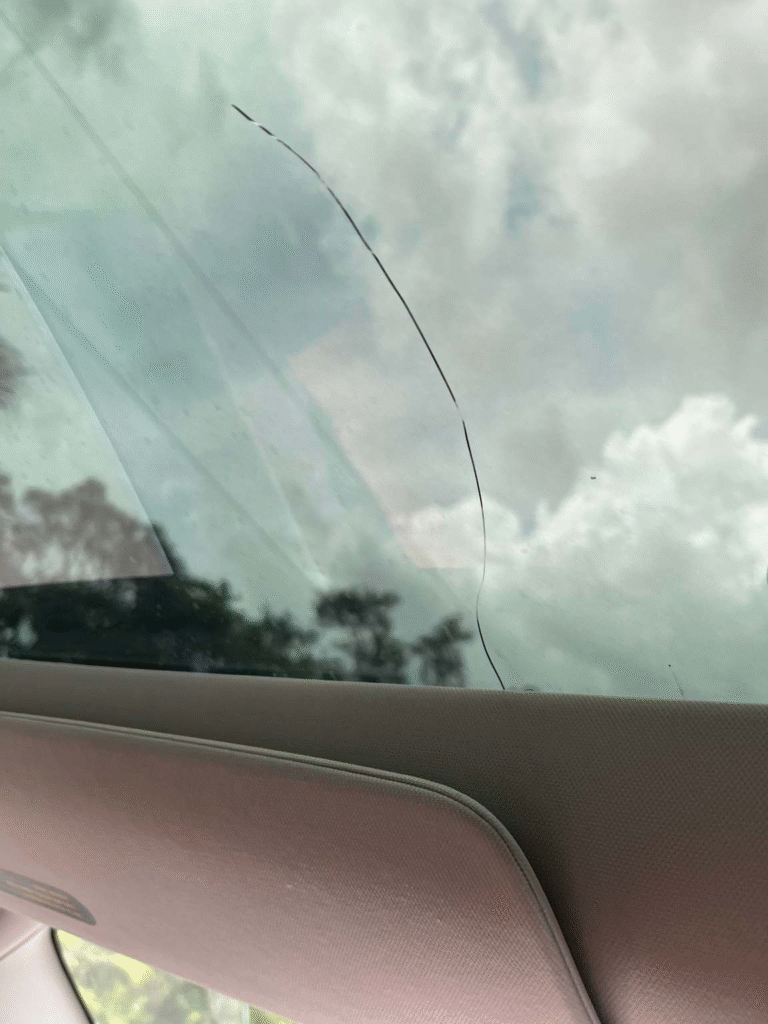
Interior Features and Technology Integration
Essential Technology Retention
Despite the barebones approach, the budget Model Y retains core Tesla technological advantages that define the brand experience. The 15.4-inch central touchscreen remains unchanged, providing full access to Tesla’s software ecosystem including over-the-air updates, Netflix streaming, and comprehensive vehicle controls. This ensures that budget buyers receive the fundamental Tesla experience without compromise to core functionality.
Autopilot hardware remains standard, including the camera array and processing capability necessary for Tesla’s driver assistance features. Level 2 ADAS functionality continues to be available, providing adaptive cruise control, lane keeping assistance, and automatic emergency braking capabilities that justify the premium over conventional vehicles in this price range.
Wireless connectivity features including 5G capability and smartphone integration remain functional through the central infotainment system. Apple CarPlay and Android Auto provide seamless smartphone integration, while wireless charging maintains convenience for compatible devices.
Seat Configuration and Comfort
The standard seat configuration provides adequate comfort for daily use while eliminating costly premium features. Manual adjustment mechanisms replace power seating to reduce complexity and cost, though heating functionality remains available for front seats. The vegan leather and cloth combination provides durability while supporting Tesla’s sustainability commitments.
Read More : Jagdeep Dhankhar’s resignation : NJAC to Basic Structure
Five-passenger seating remains standard with 60/40 split-folding rear seats for cargo flexibility. The flat floor design maintains Tesla’s advantage in rear passenger comfort, particularly for middle seat occupants. Headroom and legroom specifications remain unchanged from premium variants, ensuring passenger comfort is not compromised by the budget positioning.

Performance Specifications and Capabilities
Powertrain Configuration
The budget Model Y utilizes the same rear-wheel-drive powertrain as the standard RWD variant, delivering 295 bhp and 420 Nm of torque. 0-100 kmph acceleration in 5.9 seconds provides adequate performance for most driving scenarios while maintaining efficiency advantages over internal combustion alternatives.
Range specifications remain competitive with the 60 kWh battery pack delivering 500 km MIDC range. This positions the budget variant favorably against competitors while providing sufficient range for both urban commuting and highway touring. Real-world efficiency benefits from the simplified interior systems and conventional roof aerodynamics.
Charging Infrastructure Compatibility
CCS-II charging compatibility ensures access to India’s expanding charging infrastructure without compromise. DC fast charging capability enables rapid charging for long-distance travel, while AC charging compatibility supports home and workplace charging solutions. Tesla Supercharger network access provides additional charging convenience for owners.
Charging speeds remain unchanged from premium variants, with DC fast charging enabling 10-80% charging in approximately 38-40 minutes using compatible high-power chargers. This maintains the practical advantage of Tesla ownership despite the budget positioning.
Market Positioning and Competitive Analysis
Pricing Strategy Assessment
At Rs 59.89 lakh ex-showroom, the budget Model Y undercuts BMW Z4 by over Rs 17 lakh while offering superior acceleration and zero-emission driving. Competitive positioning against BYD Sealion 7 (Rs 53 lakh) becomes more challenging, though Tesla’s Supercharger network access and software ecosystem provide differentiation advantages.
Value proposition analysis reveals that despite feature elimination, the budget Model Y retains core Tesla advantages including autonomous driving capability, over-the-air updates, and superior build quality compared to domestic alternatives. Total cost of ownership benefits from elimination of glass roof maintenance and simplified interior systems.
Target Customer Analysis
The budget Model Y targets price-sensitive Tesla enthusiasts who prioritize brand association and core functionality over luxury features. Early EV adopters seeking reliable electric mobility without premium pricing find significant value in the simplified approach. Corporate fleet buyers benefit from lower initial costs while maintaining Tesla’s technological advantages.
Urban professionals requiring efficient daily transportation appreciate the elimination of potentially problematic features while retaining essential Tesla capabilities. Second-car buyers in affluent households find the budget positioning attractive for supplementary vehicle needs without full premium investment.
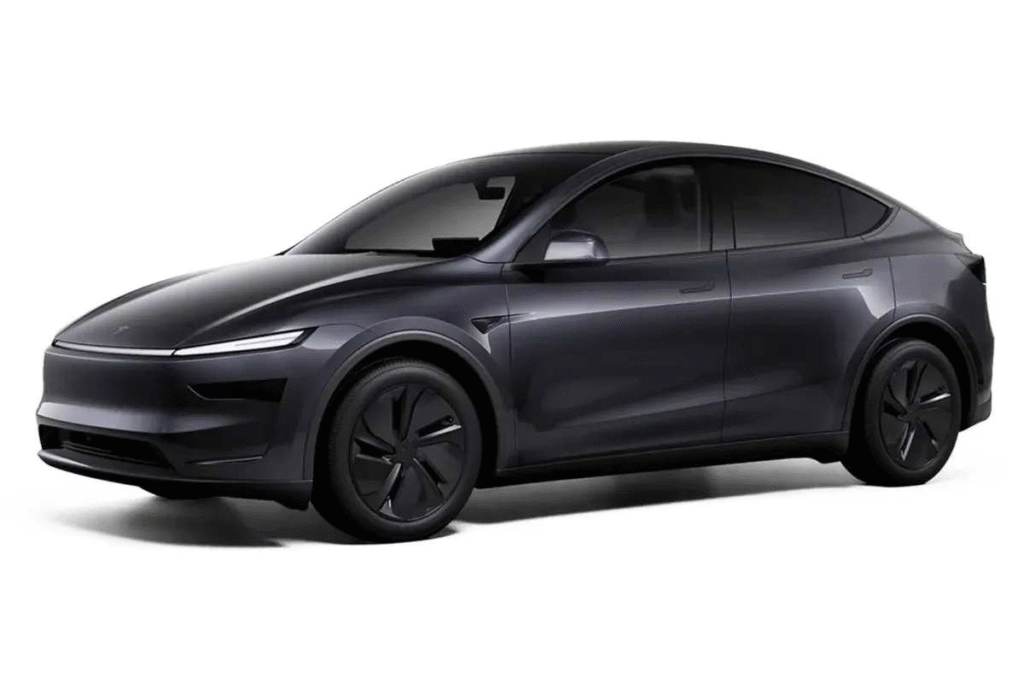
Safety and Reliability Considerations
Structural Safety Improvements
Conventional roof construction enhances crash safety through improved structural rigidity and predictable deformation characteristics. Rollover protection improves significantly without the potential for glass roof failure during impact scenarios. Emergency egress becomes more straightforward without complex glass removal requirements for rescue operations.
Read More : Jagdeep Dhankhar’s resignation : NJAC to Basic Structure
Fire safety considerations benefit from elimination of large glass surfaces that can complicate emergency response procedures. Structural integrity maintains Tesla’s 5-star safety rating while potentially improving specific crash test categories related to roof strength and occupant protection.
Long-term Reliability Predictions
Simplified systems reduce potential failure points throughout the vehicle’s lifecycle. Elimination of complex ventilation systems, rear displays, and glass roof assemblies reduces warranty claims and long-term maintenance requirements. Total cost of ownership improves through reduced complexity and associated repair costs.
Quality control improvements result from manufacturing simplification, reducing assembly complexity and potential defects. Service accessibility improves through elimination of specialized components requiring specific technician training or tools.
Future Implications and Market Impact
Industry Influence on EV Segment
Tesla’s barebones approach challenges industry assumptions about electric vehicle feature requirements and pricing strategies. Successful market acceptance could encourage other manufacturers to offer similar simplified variants, democratizing electric vehicle access while maintaining core technological advantages.
Manufacturing efficiency improvements demonstrated by the budget Model Y approach could influence Tesla’s broader product strategy, potentially extending simplified approaches to other models in the lineup. Cost reduction methodologies proven successful could enhance Tesla’s competitive positioning across all market segments.
Ownership Experience Evolution
Budget Model Y owners will experience Tesla ownership without traditional luxury expectations, focusing on core electric vehicle advantages including performance, efficiency, and technological sophistication. Community acceptance within Tesla ownership circles will depend on recognition that simplified features do not compromise fundamental brand values.
Resale value considerations will develop over time as the market determines whether simplified Tesla variants maintain brand premiums compared to fully-featured alternatives. Insurance costs may benefit from elimination of expensive-to-replace glass roof components and simplified interior systems.
Conclusion: Redefining Electric Vehicle Value
The budget Tesla Model Y without glass roof represents a strategic evolution in Tesla’s market approach, prioritizing accessibility and reliability over luxury features while maintaining core brand advantages. Elimination of the problematic glass roof solves persistent quality issues while reducing ownership costs, creating a more practical ownership experience for budget-conscious buyers.
Strategic feature reduction demonstrates that Tesla’s fundamental value proposition – superior electric powertrain, advanced software, and autonomous driving capability – remains compelling without premium interior appointments. Market success of this approach could reshape consumer expectations for electric vehicle features and pricing across the industry.
The Rs 59.89 lakh pricing positions Tesla competitively against premium combustion engine alternatives while offering zero-emission driving and access to Tesla’s expanding Supercharger network. Long-term ownership benefits from elimination of glass roof maintenance and simplified systems create compelling value for practical-minded electric vehicle buyers.
For Indian consumers seeking authentic Tesla ownership experience without premium pricing, the budget Model Y offers optimal balance of brand prestige, technological advancement, and practical reliability. Success in the Indian market will depend on consumer acceptance of simplified features in exchange for Tesla’s core advantages and improved long-term reliability.
Read More : WI vs AUS T20: Green and Owen Shine in Thriller



